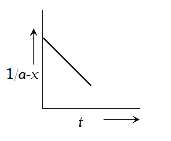For the reaction A→ Product
k=1t[1a−x−1a]
Where k is rate constant (in mol−1s−1) and (a−x) are the concentration of A at the start and after time interval t sec. A graph between 1a−x and time t is of the following




The correct Answer is:C
To solve the problem, we start with the given equation for the reaction:
k=1t(1a−x−1a)
Where:
- k is the rate constant (in mol−1s−1),
- a is the initial concentration of reactant A,
- x is the amount of A that has reacted after time t.
Step 1: Rearranging the Equation
We can rearrange the equation to express 1a−x in terms of t:
kt=1a−x−1a
Adding 1a to both sides gives:
1a−x=kt+1a
Step 2: Identifying the Linear Form
This equation can be compared to the linear equation y=mx+c, where:
- y=1a−x,
- m=k (the slope),
- x=t (the independent variable),
- c=1a (the y-intercept).
Step 3: Analyzing the Graph
From the rearranged equation, we can conclude:
- The graph of 1a−x versus t is a straight line.
- The slope of this line is positive since k is a positive rate constant.
- The y-intercept is 1a.
Step 4: Evaluating the Options
Now, we need to evaluate the given options for the graph:
1. A graph with a negative slope is incorrect because k is positive.
2. A graph with a zero slope is incorrect because k is not zero.
3. A graph with a positive slope and a y-intercept of 1a is correct.
4. A graph with a zero slope is again incorrect.
Thus, the correct option is the one that shows a straight line with a positive slope and a y-intercept at 1a.
Conclusion
The graph of 1a−x versus time t will be a straight line with a positive slope k and a y-intercept of 1a.
- k is the rate constant (in mol−1s−1),
- a is the initial concentration of reactant A,
- x is the amount of A that has reacted after time t.
- y=1a−x,
- m=k (the slope),
- x=t (the independent variable),
- c=1a (the y-intercept).
- The graph of 1a−x versus t is a straight line.
- The slope of this line is positive since k is a positive rate constant.
- The y-intercept is 1a.
1. A graph with a negative slope is incorrect because k is positive.
2. A graph with a zero slope is incorrect because k is not zero.
3. A graph with a positive slope and a y-intercept of 1a is correct.
4. A graph with a zero slope is again incorrect.
Similar Questions
Knowledge Check
Given that for a reaction of order n, the integrated from of the rate equation is :
k=1t(n−)[10Cn−1−1Cn−10] where C0 and C are the values of the reactant concentration at the start and after tme t. What is the relationship between t3/4 and t1/2 where t3/4 is the time required for C to become 14C0?At3/4=t1/2[2n−1+1]Bt3/4=t1/2[2n−1−1]Ct3/4=t1/2[2n+1−1]Dt3/4=t1/2[2n+1+1]Given that for a reaction of nth order, the integrated rate equation is:
K=1t(n−1)[1Cn−1−1Cn−10], where C and C0 are the concentration of reactant at time t and initially respectively. The t3/4 and t1/2 are related as t3/4 is time required for C to become C1/4) :At3/4=t1/2[2n−1+1]Bt3/4=t1/2[2n−1−1]Ct3/4=t1/2[2n−1−1]Dt3/4=t1/2[2n+1+1]Graph between log k and 1/T [where K is rate constant in s−1 and T is the temperature (in K) is a straight line with Hence, Ea will be
 A2.303×2 calB22.303calC2 calDNone of these
A2.303×2 calB22.303calC2 calDNone of these
Rate constant k=2.303 −1min for a particular reaction. The initial concentration of the reactant is 1 mol/litre then rate of reaction after 1 minute is:
View SolutionFor a reation: A→ Product,
rate law is −d[A]dt=K[A]0.
The concentration of A left after time t when t=1K is:
View SolutionA reaction is said to be first order if it's rate is proportional to the concentration of reactant Let us consider a reaction
A(g)→B(g)+c(g)
At t=0a00
At time t a−xxx
The rate of reaction is given by the expression dxdt=k(a−x) and integrated rate equation for a given reaction is represted as k=1tln(aa−x) where a=initial concentration and (a-x) = concentration of A after time t.
Consider a reaction A(g)→3B(g)+2C(g) with rate constant 1.386×10−2−1min starting with 2 moles of A in 12.5 litre vessel initially if reaction is allowed to take place at constant pressure and at allowed to take place at constant pressure and at 298 K then find the concentration of B after 100 min.
View SolutionRate constant k=2.303min−1 for a particular reaction. The initial concentration of the reaction is 1. mol/L, then rate of reaction after 1 minute is
View SolutionFor two reactions,
I:A→B Rate constant=k1sec−1
II:C→D Rate constant=k2M−1sec−1
Starting with initial concentration of 1M each, time taken to reach to 0.5M is same, then, identify the correct options.
View Solution

